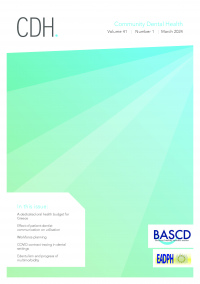June 2011
Mesial migration and loss of first molars among young adolescents in Kuwait
Abstract
Objective Our aim was to determine the prevalence of and factors associated with mesial migration and/or loss of first molars in 13-14-year-old school children in Kuwait. Methods A population-based sample of 1,583 eighth grade students of mean age 13.23±0.42 yrs, representing about 7% of the target population, were selected using multistage cluster sampling methods. Information on nationality, family income, and number of siblings was collected through subject and family interview. Any mesial migration or loss of first molars as well as visible caries was recorded in a well lit classroom. Results The prevalence of mesial migration and/or loss was 11.4%. Almost 70% of this occurred only in the mandible, and the majority (75.7%) had only one tooth affected (p<0.01). Although the prevalence differed with residential geographical regions (p<0.01), there were no gender differences (p>0.05). The prevalence also differed with family income (p<0.05), increased (p<0.05) with increasing number of siblings, and was higher (p<0.001) in subjects with presence of caries lesions (22.2%) than in those without (9.6%). Conclusions About 12% of current age cohorts of school children in Kuwait are likely to experience mesial migration and/or loss of one or more first molars. The conditions are associated with presence of untreated caries lesions. Private school attendance and high as well as low family income are associated with a decreased level of mesial migration and/or loss of one or more first molars. Increased number of siblings is a risk factor. Key words: First molar loss, mesial molar migration, prevalence, risk factors.




